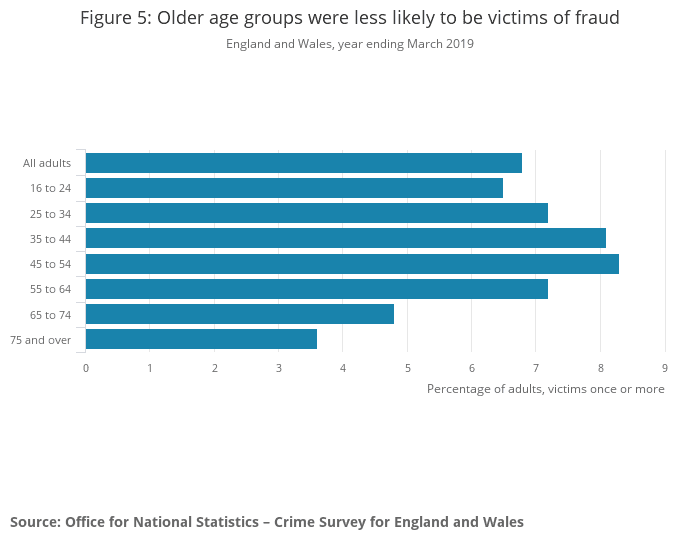A UK adult has at least a 6.8% chance of being hit by fraud in a year, more than double their chances of being a victim of criminal damage.
Younger people are more likely to be victims than those over 65, although different scams target different groups.
Plus, regional differences and household variations show that if you're an affluent professional in London or the south of England, you're more likely to be a victim.

How many people are hit by fraud?
An estimated 3.8 million people were victims of fraud between April 2019 and March 2020 according to figures from the Crime Survey for England and Wales (CSEW).
Comparison figures are only available back to 2017, but there has been an increase in recorded incidents since then - the figure was 3.4 million that year.
The rate of fraud was 78 cases for every 1,000 members of the population. To put this in context:
- Fraud is almost twice as likely as criminal damage
- You are almost four times as likely to be a victim of fraud than to have your bike stolen
- A person is three times more likely to be a victim of fraud than to be a victim of violence or domestic burglary
- Fraud is more likely than bike theft, violence and domestic burglary combined
So, there's no denying fraud is a major part of modern life, and this is backed with data from other sources.
Fraud recorded by other organisations
There was a 39% rise in offences relating to UK-issued payment cards, cheques and remote banking reported to UK Finance in 2018/19 compared to 2017/18.
This amounted to 2.8 million offences included in the figures compiled by the body representing 250 firms in the banking and finance industry.
This was in addition to fraud recorded by UK Finance and referred to the National Fraud Intelligence Bureau (NFIB).
The NFIB collates fraud information referred from UK Finance, Cifas and Action Fraud, and 679,775 offences were referred in the year to March 2019.
Problems with collating fraud data
The major issue with trying to pinpoint how much fraud there is in the UK every year is the fact that underreporting can make the figures seem lower than they really are.
So, the 3.8 million figure quoted in the most recent CSEW above is a base figure rather than a true total.
Remember, too, Scotland and Northern Ireland aren't included in CSEW data, meaning the true scale of fraud is higher than these figures suggest.
One final point: the Office for National Statistics (ONS) concede there may be a slight overlap in fraud reported through different sources to the NFIB but they believe any duplication is so small that it's statistically insignificant.
We'll delve into the most common fraud offences later in this guide, but first let's look at who's most likely to be hit by fraud.
Who is most likely to be hit by fraud?
The CSEW shows there's little statistical variation between different groups of people - so, anyone could theoretically be a victim of fraud.
However, they did point to lower instances in older age groups and higher instances in households earning a higher income.
According to CSEW:
- 6.8% of adults are victims of fraud once or more
- Adults over 65 are less likely to be a victim of fraud than younger people
- Adults in households earning £50,000 or more were the most likely victims of fraud
- People living in the East of England, the South East and London were the most likely to be victims of fraud
- Around one in eight adults who have been the victim of a fraud will be victimised multiple times
Some of these figures may be surprising, so let's have a closer look.
Age of fraud victims
CSEW data shows people between the ages of 35 and 54 are the most likely to be victims of fraud while those over 65 were the least likely:

This may be a surprise given public discussion around fraud which seems to suggest older people are more at risk.
Certainly, there are some schemes in place to target older people hit by fraud attempts such as the Banking Protocol which has prevented £116m being defrauded up to the middle of 2020, including £19m in the first six months of the year.
Yet if we look at the 2019 figures for authorised push payment (APP) fraud alone, we see losses of £317.1m in one year for personal banking customers.
It's true older people are more likely to be targeted by certain types of fraud, including the types spotted by in-branch staff and reported to police under the Banking Protocol.
The CSEW notes the types of fraud where older people are more likely to be victims are a small proportion of the fraud included in their figures.
Impact of household income on fraud
People in managerial and professional occupations are more likely to be victims of fraud than those in other occupations.
These are the CSEW figures for the year to March 2019:
| Occupation | Percentage victims of fraud |
|---|---|
| Managerial and professional | 8.6% |
| Intermediate occupations | 7% |
| Routine and manual | 5.4% |
| Never worked and long-term unemployed | 3.7% |
| Full-time students | 5.1% |
| Not classified | 3% |
Within those figures, people in managerial and professional roles have a 6% chance of being a victim of bank and credit account fraud and a 2.4% chance of being a victim of consumer and retail fraud.
If we take an alternative view and look at education rather than occupation, we can see a similar split:
| Highest qualification | Percentage victims of fraud |
|---|---|
| Degree or diploma | 8.7% |
| Apprenticeship or A/AS level | 6.9% |
| O level or GCSE | 6% |
| Other | 4.7% |
| None | 3.2% |
So, the higher your professional status and the higher your qualifications are, the more likely you are to be a victim of fraud.
Regional differences in fraud
Fraud victims are more likely to be found in London and the south of England.
CSEW data shows these regional splits:
| Region | Percentage victims of fraud |
|---|---|
| North East | 3.6% |
| North West | 5.6% |
| Yorkshire and the Humber | 6% |
| East Midlands | 7.5% |
| West Midlands | 5.3% |
| East | 8.3% |
| London | 7.9% |
| South East | 7.9% |
| South West | 7.1% |
| Wales | 5.7% |
CSEW say these figures are broadly consistently with the data supplied by Action Fraud which showed the North East had the lowest rate of fraud offences recorded while London, the East of England and the South East had the highest rates in the year to March 2019.
So, fraud victims are more likely to be found in the south, although only the North East registers a figure below 5.6%.
What are the most common types of fraud?
Bank and credit account fraud are by far the most common frauds reported within the CSEW for the year to March 2019.
The categories look like this:
| Fraud type | Number of cases | Percentage of adults as victims |
|---|---|---|
| Bank and credit account fraud | 2.6 million | 4.6% |
| Consumer and retail fraud | 1 million | 2% |
| Advance fee fraud | 57,000 | 0.1% |
| Other fraud | 154,000 | 0.3% |
People are twice as likely to be victims of bank and credit account fraud than other categories.
Here's how the CSEW categorises different types of fraud:
| Category | Includes |
|---|---|
| Bank and credit account fraud | Fraudulent access to bank, building society or credit card accounts, fraudulent use of plastic card details |
| Advance fee fraud | Lottery scams, romance fraud, inheritance fraud |
| Consumer and retail fraud | Bogus callers, ticketing fraud, phone scams, computer software service fraud |
| Other fraud | Investment fraud, charity fraud |
From this data, we can see UK adults are most at risk of fraudulent access to accounts or unauthorised use of their debit and credit card details.
What about APP fraud?
Authorised push payment (APP) fraud takes place when individuals or businesses are tricked into transferring their money elsewhere.
UK Finance figures show £455.8m was lost to APP fraudsters in 2019, with £317.1m of that being scammed from individuals and the rest from businesses.
There were 122,437 cases reported to UK Finance with 114,731 on personal accounts.
Overall, this is an increase of 29% compared to the previous year, and it's this persistent rise that has prompted the implementation of the APP Voluntary Code to protect victims.
The Code was introduced by some payment providers in May 2019 and means customers can be reimbursed if they unwittingly transfer money to a scammer.
It isn't a catch-all though - only 41% of cases assessed resulted in reimbursement in the first seven months of the scheme.
Plus, the sector's still in need of a long-term plan as the APP Voluntary Code is due to expire in December 2020.
Levels of identity fraud
Identity fraud is another type of fraud that gets plenty of attention, and there was an 18% increase in cases reported to the National Fraud Database (NFD) in 2019 compared to the year before.
Victims of identity fraud were mainly over 31 and there has been a rise of 22% in victims aged over 61.
Read more about those figures here.
Or find out about data from Lloyds Bank which suggests a four-fold increase in the number of younger victims of impersonation scams.
Other frauds to be aware of
If we look closely at the CSEW figures, we can see there are some specific fraud types we should all be more aware of.
These are some notable ones:
| Type of fraud | Number of cases in 2018/2019 |
|---|---|
| Online shopping and auctions | 51,016 |
| Door to door sales and bogus tradespeople | 5,837 |
| Dating scams | 4,589 |
| Consumer phone fraud | 2,117 |
| Lottery scams | 1,201 |
How to prevent fraud
As we've seen, there's around a 6.8% chance we'll become a victim of fraud - and this is a conservative estimate as some fraud still goes unreported.
Worrying research from Santander published in June 2020 found that almost one in two Brits would move their money to a so-called safe account if prompted by someone in authority over the phone.
So, it's important we learn how to protect ourselves and understand the different types of frauds out there.
Read the Choose guides to online scams, telephone scams and loan scams to gain a deeper understanding of how scammers operate and what you can do to protect yourself.
Conclusion: Stay scam aware
It's difficult to get a complete picture of the amount of fraud in the UK every year, but it's clear that many people are at risk and scammers are becoming more sophisticated every year.
A disproportionate focus in the press and elsewhere on scams affecting older people could mask a real problem for younger affluent adults, so it's important everyone understands they're at risk from fraud in one way or another.
We're more likely to be a victim of fraud than almost any other crime, and it's still on the rise - take steps to protect yourself and don't get caught out.








Comments